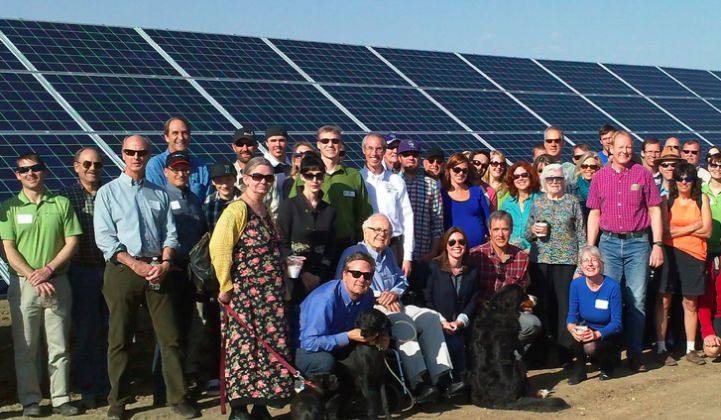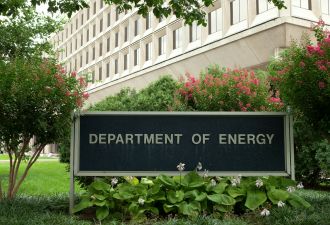Late last year, we reported that First Solar made its entry into the U.S. residential solar market by becoming the largest single investor in Clean Energy Collective's community solar business.
At the time, the financial details of the transaction were "undisclosed."
But the 2014 First Solar SEC filing reveals all.
According to First Solar's SEC filing. "In November 2014, we entered into various agreements to purchase a 28% ownership interest in Clean Energy Collective, LLC (CEC) for $21.8 million, including $0.8 million of transaction costs. This investment represented our latest entry into the distributed generation market and provided us with a partner to develop and market community solar offerings to North American residential customers and businesses directly on behalf of client utility companies. As part of the investment, we also received a warrant, valued at $1.8 million, to purchase additional ownership interests of approximately 7% at prices at or above our initial investment price per unit."
"In addition to our equity investment in CEC, we also entered into a loan agreement to provide CEC with term loan advances up to $15.0 million, of which CEC borrowed an initial amount of $9.1 million. All loans are due in November 2017 on the third anniversary of the initial loan agreement. Interest is payable semiannually and may be capitalized to the outstanding principal balance of the loans at CEC’s election. The loans bear interest at rates ranging from 7% to 16% depending on CEC’s current capital structure. As of December 31, 2014, the balance outstanding on the loans was $9.1 million." (Thanks to GTM Research analyst Cory Honeyman for spotting this.)
As we reported in December, Clean Energy Collective (CEC) builds and sells community solar projects to residential and small business customers on behalf of utilities.
First Solar made an investment in CEC, gained an equity interest and took two seats on the board. In December 2012, CEC won $13 million in equity financing from the New Energy Capital Cleantech Infrastructure Fund, Black Coral Capital and other investors.
“Our model is not supplanting people who want to and can put solar on their house, but rather opening the market to the other 75 percent of electricity users,” explained CEC's president, Paul Spencer, in a previous interview. Community solar doubles or triples the potential market for solar, according to CEC.
Jim Hughes, First Solar’s CEO, told GTM, "I have been talking about community solar for more than two years. We thought it would take time for utilities and [public utilities commissions] to understand it as a good solution." Hughes notes that "CEC, while small, is the leader, so far. We think we supplement their capabilities nicely." Hughes noted First Solar's skills as an EPC, adding, "We have a close relationship with the utilities."
Hughes also said that CEC has strength in marketing the community solar project. The First Solar CEO added that residential solar today is all about customer acquisition.
Hughes clarified the process, saying, "The consumer will continue to get the utility bill, which will reflect the energy production in their interest and will reflect full credit."
The "vast majority" of projects will utilize First Solar's thin-film modules.
Hughes noted that First Solar did not outright acquire CEC because it was "sensitive to impairing the ability for a startup to grow rapidly, and [with acquisition] you run a risk that you distract the management team."
Hughes suggests that community solar allows the utility to better integrate solar and maintain some control of the resource.
As we've reported, the model is simple on paper, but it's very complex in practice. Corporate structure, securities and tax issues, tracking, and utility-bill crediting all need to be up and running to allow this model to scale. CEC’s projects take advantage of virtual net metering, which “allows net-metering credits generated by a single renewable system to offset load at multiple retail electric accounts," according to NREL.
In a previous interview, CEC told GTM, "Solar owners must be utility customers and cannot buy more than 110 percent of their yearly electricity consumption. Ownership is transferable. If an owner moves within the utility’s service territory, the bill credits follow. If the customer moves outside of the territory, panels can be sold to another customer or to CEC, or donated to a nonprofit."
“Distributed generation in the form of community solar expands the addressable market dramatically beyond the traditional residential or commercial sectors, and CEC has led the way in making that happen,” said First Solar's Hughes.
Steve Krum, director of corporate communications at First Solar, commented to GTM, "Community solar is recognized as the most efficient and cost-effective model for broad customer accessibility in residential and commercial markets."
To date, CEC has experience landing subscribers for projects 2 megawatts and below. CEC started in Colorado and has built or has under development more than 40 community solar projects representing 36 megawatts of community solar capacity in a number of states.



